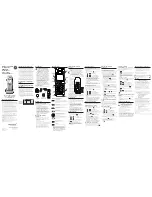
10
11
SPECIFIC GRAVITY
The specific gravity of electrolyte in a battery cell is the most accurate measurement
of actual state-of-charge. Specific gravity decreases during discharge and increases
again as the battery is charged. To determine if a battery has reached full charge, test a
sample of the electrolyte in each cell using a hydrometer or refractometer.
The specific gravity of a fully charged battery will vary according to the pre-mixed
electrolyte added during manufacturing. For reference, this is noted on the battery label.
RAILROAD & DIESEL
STARTER MODELS
ELECTROLYTE
8V MODELS
1.250 S.G.
32V MODELS
1.265 S.G.
Routine testing of specific gravity in flooded lead-acid batteries provides an opportunity
to quickly identify any notable changes in battery performance caused by charge-
related issues such as over/undercharging, sulfation buildup, capacity loss, cell/battery
performance or failures.
Routine testing and tracking of specific gravity readings is suggested as part of the
normal battery maintenance procedures. When monitored regularly, varying or low
readings may be identified early on, and charge adjustments made to quickly correct
and prevent any further issue or damage.
EFFECT OF TEMPERATURE ON SPECIFIC GRAVITY
Temperature will affect the specific gravity reading of electrolyte. When taking specific
gravity readings with a hydrometer or refractometer, it is important to correct for
ambient temperature.
To adjust a specific gravity reading for varying ambient temperature, one point (.001)
should be added for every 1.6°C (3°F) above 25°C (77°F). Alternatively, one point (.001)
should be deducted for every 1.6°C (3°F) below 25°C (77°F).
As an example, a specific gravity reading of 1.265 at 17°C (63°F) corrected for
temperature would be 1.260. A specific gravity reading of 1.265 at 30°C (86°F)
corrected for temperature would be 1.268.
Battery capacity is also based on each cell having an electrolyte temperature of 25°C
(77°F). Temperatures below 25°C (77°F) reduce the battery’s effective capacity and
lengthen the time to restore to full capacity. Temperatures above 25°C (77°F) will
slightly increase capacity but will also increase self-discharge rates as well as cell
degradation, shortening battery life.
Summary of Contents for 16 CH 25P
Page 2: ...RAILROAD DIESEL STARTER ...
Page 27: ...25 ...













































